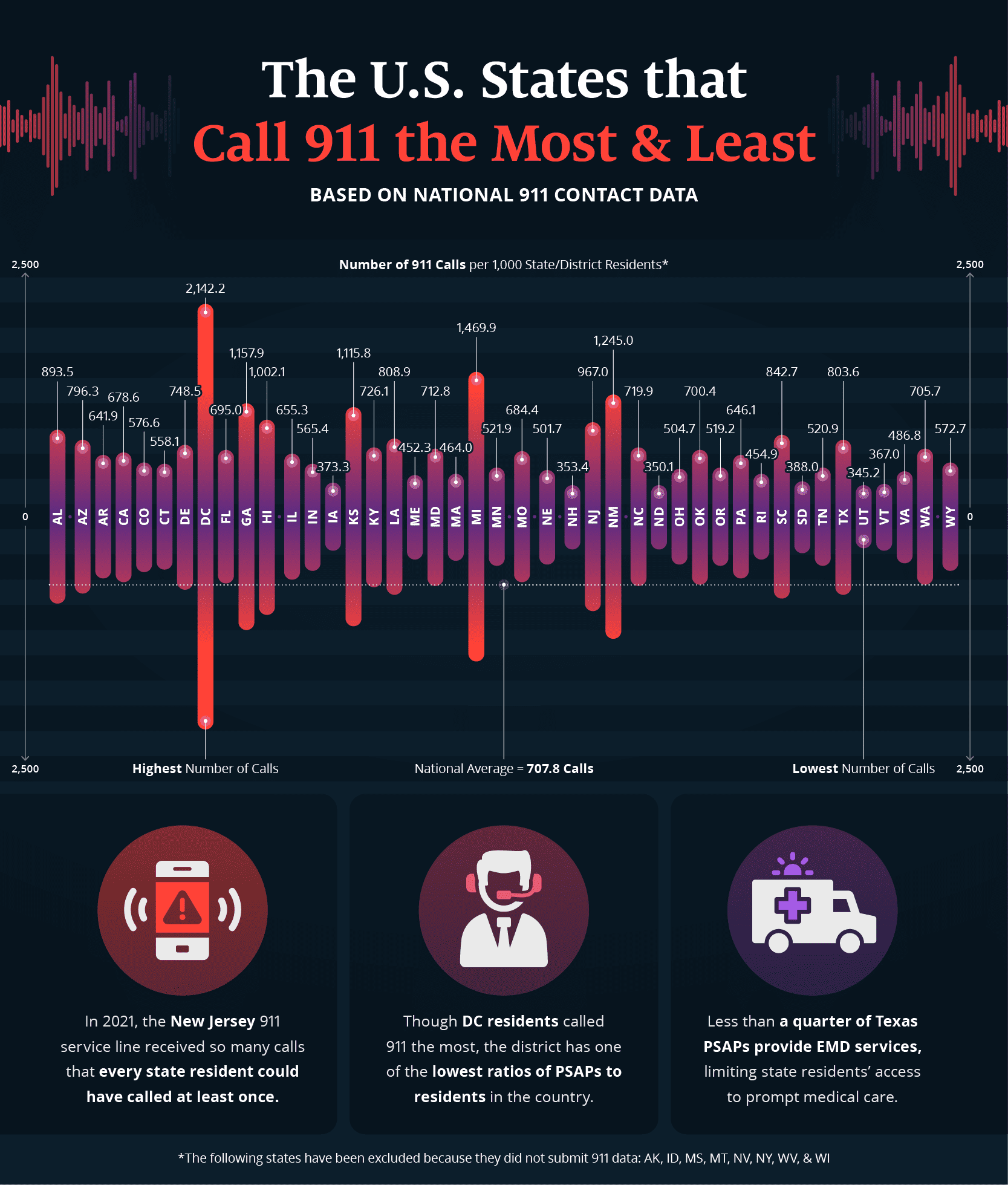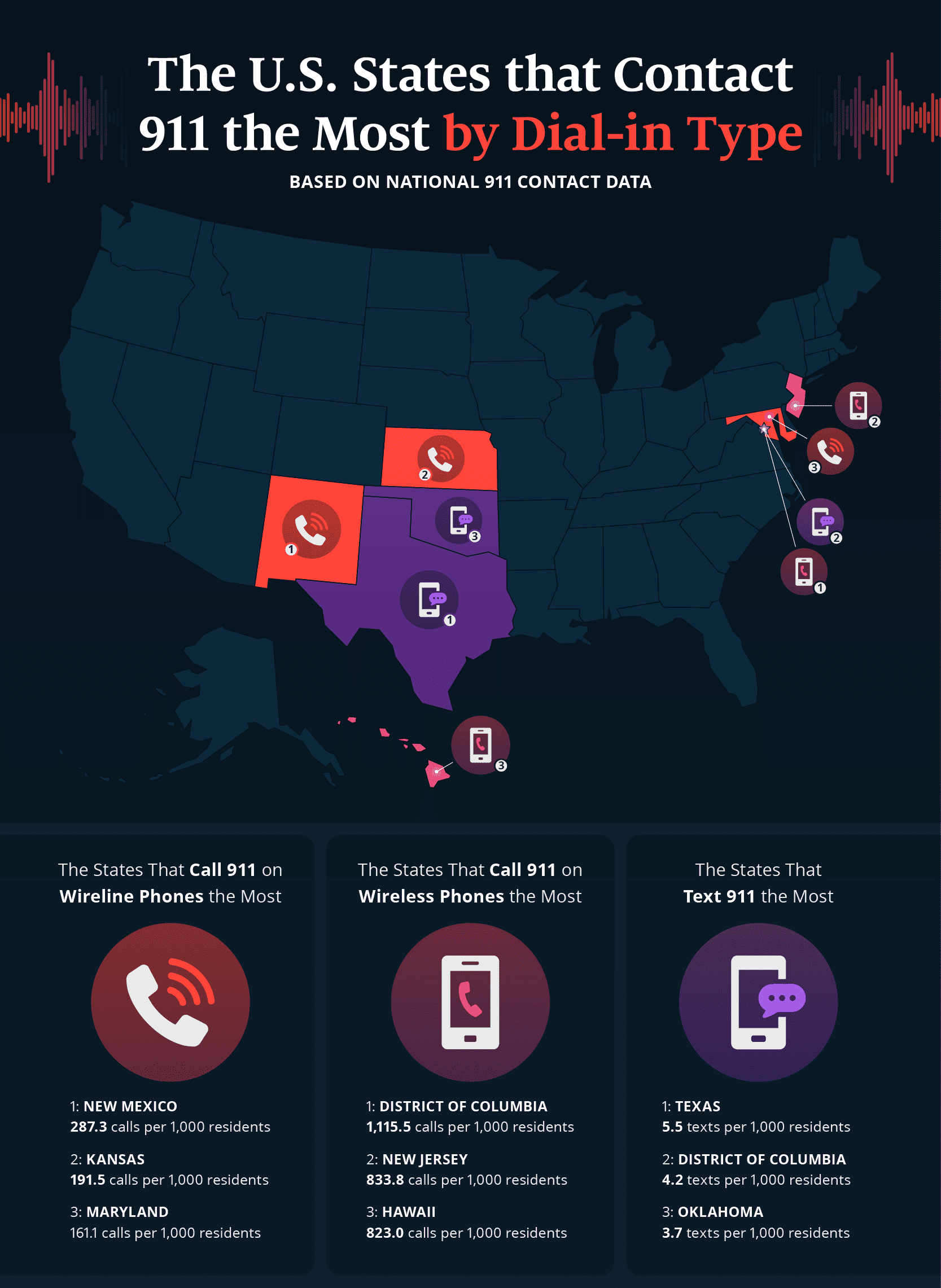While we all hope we never witness a crime or need emergency support, there may come a time when we have to dial 911 or require immediate medical attention.
But where in the U.S. are people contacting emergency services more often?
Here, we analyzed national 911 data to determine which states call 911 the most overall and which require the most Emergency Medical Dispatch (EMD) support. This exploration aims to shed light on the areas where individuals reach out to 911 more frequently and provide an understanding of the demand for emergency assistance. Read on to see what we found.
U.S. States that Call 911 the Most & Least

In 2021, New Jersey residents made an average of approximately one 911 call per person. In contrast, the residents of Washington, D.C. surpassed this figure, averaging around two 911 calls per person over the same period.
Public Safety Answering Points (PSAPs) are specialized call centers that serve as the primary contact for individuals dialing emergency services, typically 911. They are responsible for receiving incoming emergency calls and directing them to the required emergency services.
PSAPs play a critical role in emergency response systems as the link between the public and emergency services, ensuring that emergency calls are answered promptly and handled carefully.
Despite Washington, D.C. having the highest rate of 911 calls, it is worth noting that the region possesses one of the lowest ratios of PSAPs to residents.
A lower PSAP-to-resident ratio can strain the resources available to efficiently handle the high volume of calls, potentially impacting emergency response times.
A concerning situation exists in Texas, where less than one-fourth of the state’s PSAPs provide Emergency Medical Dispatch (EMD) services. EMD services enable trained professionals to offer medical guidance over the phone until help arrives, ensuring prompt and potentially life-saving care.
With a significant portion of PSAPs in Texas lacking this service, residents across the state may face limitations in receiving immediate medical assistance during emergencies.
The States that Contact 911 the Most by Dial-In Type

Despite the increasing prevalence of mobile devices, landline telephones remain the most reliable method of contacting 911.
Wireline calls – including landlines – are associated with fixed locations, such as homes or businesses, making them valuable where accurate location information is essential for emergency responders. The stability and dedicated infrastructure of wireline phones provide a dependable means of communication in emergencies.
In 2021, New Mexico emerged as the state with the highest volume of 911 calls through wireline phones, reaching an impressive count of 287 calls per 1,000 residents annually.
Conversely, Washington, D.C. residents typically rely on cellular devices to contact 911 during emergencies. The District of Columbia topped the list at about 1,115.5 wireless calls to 911 per 1,000 residents for the 2021 year.
With the widespread use of mobile phones, individuals can quickly connect with emergency services from any location with cellular network coverage, enabling swift communication during critical situations.
Texas stood out for utilizing text-based emergency communication. In 2021, roughly 5 out of every 1,000 Texans opted for text messaging to connect with 911.
Texting is emerging as a convenient and accessible method of reaching 911 during emergencies. Texting during an emergency can be particularly beneficial for individuals with speech or hearing impairments who may find it challenging to make voice calls or for those in situations where silence or discretion is necessary.
However, it’s important to note that text-to-911 services are not supported in all areas, and voice calls are still generally recommended for immediate response in life-threatening situations.
Full Data
Explore the interactive table below for a comprehensive breakdown of how frequently each state contacts 911 and more insight into emergency service utilization across the United States.
Closing Thoughts
Analyzing national 911 data reveals insightful patterns regarding the frequency of contacting emergency services across different states in the United States. Understanding what regions people reach out to 911 more often can help highlight the areas with a higher demand for emergency assistance and provide an opportunity for emergency response services to allocate resources more effectively in these high-demand regions.
As we strive to improve our emergency response services, it is crucial for everyone to familiarize themselves with local emergency contact protocols and have a clear understanding of when to dial 911. By being prepared and informed, we can all play a part in ensuring a swift and effective response when faced with emergencies.
While calling 911 in an emergency can save your life, it can be costly for those without insurance. A reliable insurance plan can help alleviate some of the financial burdens of ambulance rides and subsequent medical procedures.
Assurance IQ can help you find a health insurance policy that suits your needs, ensuring you have the necessary coverage during unexpected emergencies.
Methodology
To find the states that call 911 the most, we analyzed all recorded 911 calls or texts using 911.gov. We searched by state in the most recent year of recorded data (2021). In addition, we determined the states with the most and least amount of PSAPs per 1,000 residents and the percent of PSAPs in each state that provide EMD. Some states did not submit data and could not be included.
